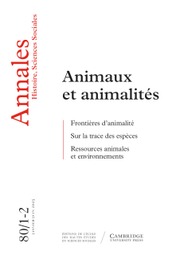No CrossRef data available.
Article contents
Edward Fram, The Codification of Jewish Law on the Cusp of Modernity, Cambridge, Cambridge University Press, 2022, 325 p.
Review products
Published online by Cambridge University Press: 30 December 2024
Abstract
- Type
- Mondes juifs médiévaux et modernes (comptes rendus)
- Information
- Copyright
- © Éditions de l’EHESS
References
1. Dans le monde des études traditionnelles et de la littérature rabbinique, ces auteurs sont généralement désignés par leurs surnoms honorifiques : pour Karo, Maran, de l’araméen, « notre maître » ou Ha-Mekhaber, « l’Auteur » ; pour Luria et Isserles, par leurs acronymes hébreux respectifs, Maharshal et Rema.
2. Le terme hébreu halakha, souvent rendu de façon imprécise par l’expression « loi juive », se traduit mieux en français, me semble-t-il, par « norme rabbinique » : ce choix évite toute représentation de la loi juive comme un système figé, reflète les possibles évolutions et porte l’écho du sens littéral d’un substantif issu de la racine verbale hébraïque « aller » en même temps qu’une injonction à suivre la voie dans laquelle il faut aller (comme c’est le cas pour la Shariah en Islam) ; c’est la traduction que prescrivait en son temps le talmudiste Charles Touati (1925-2003) à ses étudiants de la section d’études religieuses de l’École pratique des hautes études.
3. Edward Fram, Ideals Face Reality: Jewish Law and Life in Poland, 1550-1655, Cincinnati, Hebrew Union College Press, 1997.
4. Id., My Dear Daughter: Rabbi Benjamin Slonik and the Education of Jewish Women in Sixteenth-Century Poland, trad. par E. Fram et A. Romer Segal, Cincinnati, Hebrew Union College Press, 2007 ; id., A Window on Their World: The Court Diaries of Rabbi Ḥayyim Gundersheim, Frankfurt am Main, 1773-1794, Cincinnati, Hebrew Union College Press, 2012. E. Fram est le maître d’œuvre d’une base de données d’accès libre sur les responsa de l’espace ashkénaze moderne : « Rabbinic Sources for the Study of Jewish History in Eastern Europe to the Mid-Seventeenth Century », bibliothèque de l’université Ben Gurion du Néguev, https://libguides.bgu.ac.il/guide_jewish_history/rabbinic_Sources [hébr.].
5. Parmi les productions et auteurs significatifs, citons : Roni Weinstein, Joseph Karo and Shaping of Modern Jewish Law: The Early Modern Ottoman and Global Settings, Londres, Anthem Press 2022, avec le compte rendu de cet ouvrage par Pierre Savy dans le présent numéro des Annales, p. XXX-XXX ; Tirza Y. Kelman, « ‘I Shall Create Halakhic Ruling… For That Is the Objective’: The Dimension of Halakhic Ruling in Joseph Karo’s Beit Yosef » [Hébr.], thèse de doctorat, Beer-Sheva, université Ben Gurion du Néguev, 2018 ; Maoz Kahana, « A Universe of Words: Rabbi Yosef Karo’s Self-Perception as a Halakhic Codifier » [Hébr.], Jewish Law Annual, 30, 2020, p. 79-127. Sur le lien entre kabbale et halakha, voir Julien Darmon, La loi du secret. La kabbale comme source de halakha chez R. Joseph Caro et les décisionnaires ultérieurs, Paris, Honoré Champion, 2017.
6. Verena Kasper-Marienberg et Edward Fram, « Jewish Law in Non-Jewish Courts: A Case from Eighteenth-Century Frankfurt at the Imperial Aulic Council of the Holy Roman Empire », Max Planck Institute for Legal History and Legal Theory Research Paper Series, 21, 2022, https://dx.doi.org/10.2139/ssrn.4245608 ; Karl Härter, « The Early Modern Holy Roman Empire of the German Nation (1495-1806): A Multi-Layered Legal System », in J. Duindam et al. (dir.), Law and Empire, vol. 3, Ideas, Practices, Actors, Leyde, Brill, 2013, p. 111-131 ; Jay R. Berkovitz, « Reconsidering Early Modern Jewry: Reflections on the Methodology of Legal History », Jewish History, 37, 2024, p. 209-257 ; id., Law’s Dominion: Jewish Community, Religion, and Family in Early Modern Metz, Leyde, Brill, 2020 ; Jessica M. Marglin, Across Legal Lines: Jews and Muslims in Modern Morocco, New Haven, Yale University Press, 2016 ; Tamara Morsel-Eisenberg, « Anxieties of Transmission: Rabbinic Responsa and Early Modern ‘Print Culture’ », Journal of the History of Ideas, 82-3, 2021, p. 377-404 ; Zev Eleff, Roberta Rosenthal Kwall et Chaim Saiman (dir.), The Oxford Handbook of Jewish Law, Oxford Academic, 23 janv. 2024, https://doi.org/10.1093/oxfordhb/9780197508305.001.0001. S’il concède aux historiens et historiennes une place limitée, ce dernier ouvrage est une somme historiographique à jour. Pour un exemple récent de l’apport des médiévistes, voir Pinchas Roth, In This Land: Jewish Life and Legal Culture in Late Medieval Provence, Toronto, Pontifical Institute of Mediaeval Studies, 2021.
7. La première partie, « Orah Hayim », traite des lois relatives à la prière, au shabbat et aux fêtes ; la deuxième, « Yoreh Deah », des lois alimentaires, de la conversion, du deuil, de la menstruation ; la troisième, « Even Haezer », du mariage et du divorce ; et la quatrième, « Hoshen Mishpat », du droit civil et du tribunal rabbinique.
8. Sur le rapport des « codes » halakhiques aux textes antérieurs et leur diversité structurelle, voir Tirza Y. Kelman, « How Do the Codes Read Earlier Rabbinic Texts? », in Z. Eleff, R. Rosenthal Kwall et C. Saiman (dir.), The Oxford Handbook of Jewish Law, Oxford Academic, 23 janv. 2024, https://doi.org/10.1093/oxfordhb/9780197508305.013.5.
9. Il n’existe pas à ce jour de traduction complète du Shulhan Arukh. Une traduction partielle est disponible sur Sefaria : https://www.sefaria.org/texts/Halakhah/Shulchan%20Arukh.
10. Noam Samet, « How Did the Nos’ei Kelim (‘Arms-Bearers’) Read Shulhan Arukh? », in Z. Eleff, R. Rosenthal Kwall et C. Saiman (dir.), The Oxford Handbook of Jewish Law, Oxford Academic, 23 janv. 2024, https://doi.org/10.1093/oxfordhb/9780197508305.013.6.


